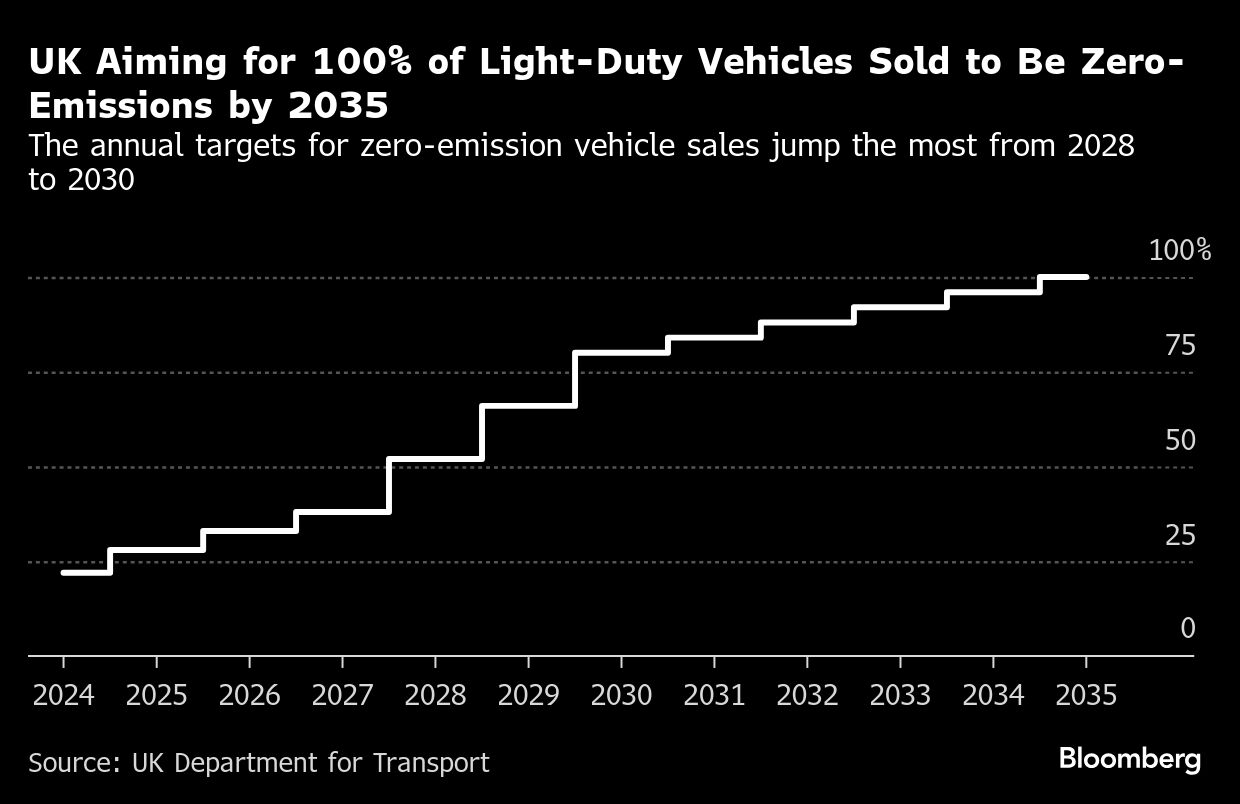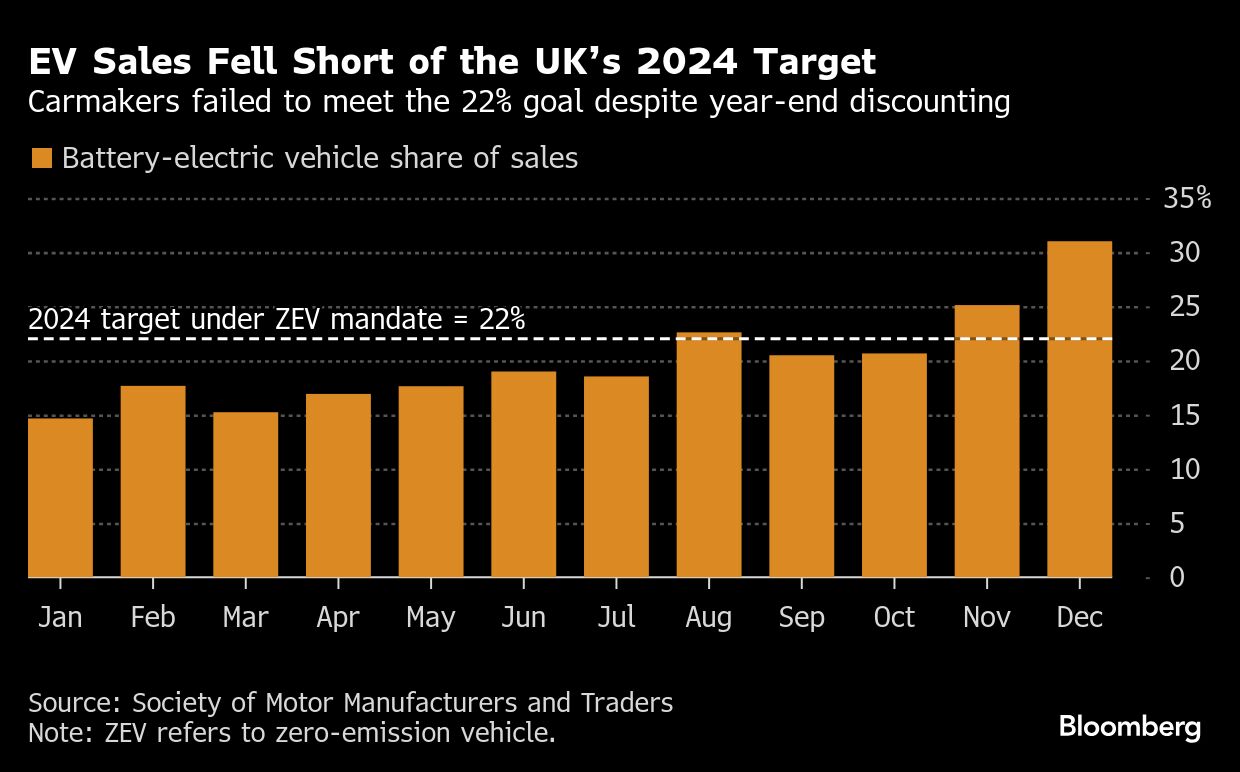(Bloomberg) -- The British government has relaxed Its goals for electric vehicles were adjusted following widespread criticism from the auto industry, which argued that the sales targets did not align with consumer demand.
According to Britain's zero-emission vehicle mandate, an increasing share of the cars and vans sold annually by each manufacturer within the country must be electric. The objective is to achieve entirely zero-emission sales by 2035; however, car makers are not meeting the intermediate yearly targets due to lower than anticipated demand for electric vehicles.
This led to a two-month governmental response. consultation On modifying the ZEV mandate’s specifications—a process completed around mid-February—after considering input from the automotive sector, the administration opted to enhance the adaptability for manufacturers in achieving these goals and cut back on the fines for failing to comply.
This relief arrived as the automobile sector was ensnared in President Donald Trump’s trade conflict, facing significant impacts. 25% tariff Regarding vehicle deliveries to the US starting from April 3rd. The United States stands as the second biggest export destination for the UK’s automobile sector following the European Union.
What does the UK’s zero-emission vehicle rule entail?
The regulation serves as the government’s plan to gradually eliminate the sale of new gasoline and diesel vehicles by 2030. In the inaugural year of this initiative, which is 2024, manufacturers must aim for their sales mix to include at least 22% zero-emission passenger cars and 10% non-polluting light commercial vehicles.
Each year, the standards become more stringent, with car emissions required to reach 28% in 2025 and van emissions set at 16%. By the close of the decade, these limits will increase further, reaching 80% for cars and 70% for vans. The ultimate objective is to ensure that all light-duty vehicles sold achieve zero emissions by 2035.

What is the functioning of the ZEV mandate?
If producers surpass the permitted number of fossil-fuel powered vehicles for sale, they incur fines of £12,000 ($15,000) per car and £15,000 per van. Nevertheless, the administration has incorporated flexibility within the program to help vehicle makers sidestep these penalties.
Automakers that exceed the required Zero Emission Vehicle (ZEV) sales targets—including companies like Tesla Inc., which exclusively sells electric vehicles— earn credits This allows companies to sell credits to those who do not meet their objectives. Additionally, manufacturers have the option to " borrow" credits from upcoming years; however, they will need to " repay" this by achieving greater compliance later on, which imposes a challenge as they would then face even stricter goals in subsequent years.
In what ways has the government relaxed the Zero Emission Vehicle regulations?
As part of the modifications introduced in April 2025, car manufacturers will have permission to market full hybrids like the Toyota Prius, along with plug-in hybrids, up until 2035 rather than the previously set deadline of 2030. This adjustment aims to provide additional time for the automotive sector to make the necessary shift.
The penalties for failing to meet the annual goals were reduced by £3,000 for both automobiles and vans. The option to utilize borrowed credits has been prolonged by three years until 2029, with all such credits needing repayment by 2030.
The government has also implemented a method for manufacturers to move credits back and forth between cars and vans if they produce both types. This means that if an auto manufacturer exceeds their target for cars but falls short on vans, they can utilize the surplus car credits to assist with meeting van standards within their operations.
Small-scale producers like luxury and performance car companies Aston Martin Lagonda Global Holdings Plc and McLaren Automotive Ltd. have been excluded from the Zero Emission Vehicle (ZEV) sales targets.
Where does the UK's ZEV mandate come from?
The UK’s requirement has parallels with a policy that has been enforced for many years. in California , the Zero-Emission Vehicle Program The U.S. state enacted its own car rules in the 1960s because of the serious health issues caused by severe smog.
In recent times, many other states throughout America have embraced California's standards. China Meanwhile, they have implemented comparable policies that increased ZEV sales, just like what Quebec and British Columbia, two Canadian provinces, have done.
How has the advancement towards the UK's zero-emission vehicle mandate been progressing lately?
Carmakers in the UK fell short of the target for 22% of new-car sales to be zero-emission in 2024. That was despite them offering £4.5 billion of EV discounts, according to the Society of Motor Manufacturers and Traders, which represents Britain’s automakers.
Approximately 20% of newly sold cars and 6.3% of vans were electric vehicles last year. However, numerous single manufacturers lag behind the general automotive sector in this aspect.

The target for zero-emission cars ramps up to 28% this year, and SMMT data suggests their share remains beneath this threshold, standing slightly under 21% up until March.
Automakers have attributed that discrepancy to a lack of demand For electric vehicles, driven by worries over costs, drivers' anxieties regarding inadequate charging stations and the possibility of getting stuck on the road with a drained battery.
How does the British automotive sector view the ZEV mandate?
Automobile companies are worried about the substantial expenses they will have to incur before the actual demand—reflected by the number of drivers genuinely interested in purchasing electric vehicles—aligns with the required quotas. In the meantime, carmakers must either provide marketing inducements or find alternative strategies. discounts , or fail to meet these goals, resulting in fines imposed by the government or purchasing credits from rivals who mostly produce outside the UK.
Stellantis NV indicated that the Zero Emission Vehicle (ZEV) mandate was among the factors prompting its decision. close The van-producing facility in Luton, England, has been manufacturing Vauxhall-branded cars for 120 years. The company behind the Citroën, Peugeot, Fiat, and Jeep marques lost several billion euros last year and faces pressure from shareholders to cut expenses globally.
Car manufacturers maintain their dedication to reducing carbon emissions in transportation and highlight significant investments they've made to convert their production facilities for manufacturing electric vehicles. Indeed, over 130 zero-emission vehicle models are currently available, with numerous others set to launch soon. As far as vans are concerned, more than half of the newest model lines provide an electric variant.
The SMMT commended the government for heeding the industry’s concerns but expressed dissatisfaction, indicating that "further measures will likely be necessary," particularly due to the potential significant impacts of US tariff decisions.
Additional tales of this nature can be found on bloomberg.com
©2025 Bloomberg L.P.
